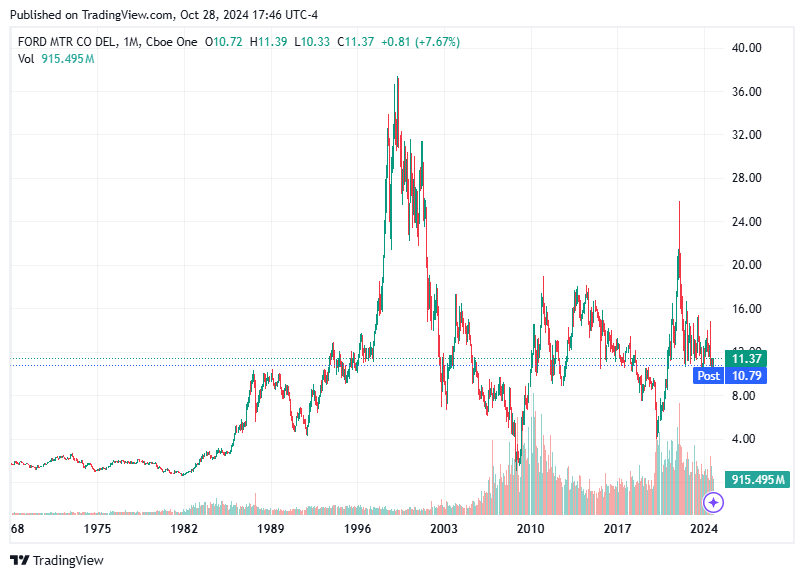Ford Motor Surpasses Q3 Expectations
Ford Motor Surpasses Q3 Expectations Amid Competitive Pressure

Disclaimer: The following article provides a detailed analysis of Ford Motor's third-quarter earnings report. The information presented here is intended for informational purposes only and should not be construed as financial advice or an endorsement of any investment strategy. Readers are encouraged to conduct their own research or consult with a qualified financial advisor before making any investment decisions.
Ford Motor Company has demonstrated resilience by reporting third-quarter earnings that exceeded market expectations. This performance comes at a time of heightened competition and economic uncertainty, challenging Ford to navigate complex market dynamics.
Financial Performance Overview
Ford's third-quarter results were a testament to its ability to adapt and thrive under pressure. The company reported adjusted earnings per share of 49 cents, surpassing the anticipated 47 cents. Automotive revenue reached $43.07 billion, exceeding the expected $41.88 billion. This indicates a 1.7% increase in revenue and a notable 19.9% rise in earnings per share compared to the previous year. These figures are noteworthy, particularly considering the challenges Ford faced in the preceding quarter.
Despite this positive momentum, Ford's stock has seen a decline of over 7% this year. This drop highlights the competitive pressures within the industry, especially as rival General Motors outperformed expectations. Ford's guidance for 2024 earnings remains on the lower end of its previously announced forecast, predicting adjusted earnings before interest and taxes (EBIT) of approximately $10 billion, down from the earlier range of $10 billion to $12 billion. It maintained its forecast for adjusted free cash flow between $7.5 billion and $8.5 billion.
Ford's third-quarter success was primarily driven by its "Pro" commercial and fleet business, along with its traditional operations, known as "Ford Blue." The "Pro" segment reported adjusted earnings of $1.81 billion, while "Ford Blue" contributed $1.63 billion. These traditional segments emphasize Ford's strength in its core operations, providing a stable foundation amid the challenges of scaling its electric vehicle (EV) initiatives.
However, Ford's "Model e" electric unit recorded losses of $1.22 billion during the third quarter. While this reflects a decrease compared to the previous year, mainly due to lower volumes, it highlights the challenges Ford faces in transitioning to electric vehicles. Despite these losses, the overall revenue for the third quarter, including the finance business, saw a year-over-year increase of about 5% to $46.2 billion.
Context and Challenges
Ford's performance in the third quarter reflects its focus on cost management and quality improvement. CFO and Vice Chair John Lawler emphasized the company's ongoing efforts to reduce costs and enhance product quality, which have been central to its recent gains. Ford has successfully achieved its target of $2 billion in material rate and manufacturing cost reductions. However, inflationary pressures and increased warranty expenses have partially offset these gains.
The automaker's warranty costs, although slightly lower than the previous year, remain a concern. These costs significantly impacted Ford's second-quarter results, and managing them effectively is crucial for sustaining profitability. Lawler noted that while some progress has been made, there is considerable potential for further improvements in cost and quality.
The automotive industry is undergoing significant transformation, driven by technological advancements and changing consumer preferences. Ford, like other industry players, faces the dual challenge of maintaining its traditional business while aggressively pursuing electric and autonomous vehicle innovations. The competitive landscape is intense, with General Motors adjusting its 2024 guidance upward and other automakers making substantial investments in electric vehicle technology.
Ford's decisions in this context are pivotal. The company's commitment to its core operations while gradually expanding its electric vehicle lineup is a balancing act that requires careful resource allocation and foresight. The pressure to innovate and meet evolving consumer demands is relentless, pushing Ford to enhance its competitive edge. Ford's ability to navigate economic uncertainties and leverage its strengths will be critical. The company's focus on cost management, quality improvement, and investments in electric vehicles will be essential to its long-term success. As the automotive landscape continues to shift, Ford's agility in responding to market changes and consumer preferences will define its trajectory.
Ford's guidance for 2024 remains cautious, signaling awareness of ongoing challenges and the need for continued adjustments. The automaker's ability to capitalize on new opportunities while managing risks will determine its capacity to exceed expectations in the future. The commitment to achieving cost efficiencies, enhancing product quality, and driving innovation will be central to Ford's approach moving forward.
Disclaimer: The information presented in this article is based on Ford Motor's third-quarter earnings report and industry analysis. It is intended for informational purposes and should not be considered as investment advice. Readers are encouraged to seek professional financial advice before making investment decisions.
We are working endlessly to provide free insights on the stock market every day, and greatly appreciate those who are paid members supporting the development of the Stock Region mobile application. Stock Region offers daily stock and option signals, watchlists, earnings reports, technical and fundamental analysis reports, virtual meetings, learning opportunities, analyst upgrades and downgrades, catalyst reports, in-person events, and access to our private network of investors for paid members as an addition to being an early investor in Stock Region. We recommend all readers to urgently activate their membership before reaching full member capacity (500) to be eligible for the upcoming revenue distribution program. Memberships now available at https://stockregion.net


